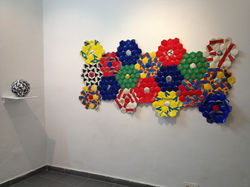CAMPO DE LAS NACIONES
Felipe Barbosa
5 febrero - 5 marzo 2013
Calle Almadén 13, Madrid
 |  |  |  |  |  |
|---|---|---|---|---|---|
 |
His aesthetic often refers to and evokes that groundbreaking concept of readymades, which Marcel Duchamp used at the beginning of the 20th century to create a new conception of art.
They were sculptural pieces based on everyday objects, sometimes found, mutilated, assembled, whose sole purpose was to question what had been considered Art for centuries. It transformed the primary utility of objects into artistic works due to the decontextualization effect.
Felipe Barbosa executes his work from the existing materials in the world, those that inhabit particularly in the house or in any area of our daily life.
This conceptual obsession with games –or with the objects used in games– is increasingly accentuated in his work. The artist recreates a pill (in English pill) made with deconstructed soccer balls. This piece has conceptual ties to General Idea's Pills and Damien Hirst's Lullaby spring. In the case of Pills by Felipe Barbosa, it is an ironic reference to how sleepy a football match can be for some and a remedy for the soporific life of others.
Soccer balls are the main sources of visual search for the making of “paintings-objects”. Buying them for their very different shapes in the colors and designs of geometric shapes, the artist disassembles them by appropriating the existing hexagons in their initial shape. This discarded geometry gives rise to new forms, which, recombined by the artist, can take on different appearances, from an oriental rug (Azulejo Bola), a Mexican mural (Mexican patchwork), a constructive painting (Plano bola, Tetris ball, Nike total blank). or pointillist (The grid, Multimarcas), a quilt (Bolas – Zigzag quilt) or a metric unit (Bolas–Tabuada). The market dynamics of the large sports product companies is one of renewal so as not to tire the buyer. Thus, the works made with soccer balls are mathematical operations and can reach an infinite number of combinations, should the artist decide to transform them into a work in progress operation.
Its explanation is the non-alteration of the initial characteristics. “I don't alter the visual capacity of an object, what I do is transform them, reducing them. I never think from the sculptural point of view, but from the ownership of existing objects. I think that the essence of the work is to try not to alter the nature of the object. My interference in general is to add information, since the memory of the object will be a constituent element of the work”.
“Art does not alter. Art formulates”. This visual game between signifier and signified is the essence of the artist's work. Felipe Barbosa, an artist who transforms objects, uses humor and irony to tear the spectator out of the passive contemplative act: “only through art can we get out of ourselves”. The work is a response to Gilles Deleuze's call for artists to introduce art into the space of lived life.






















